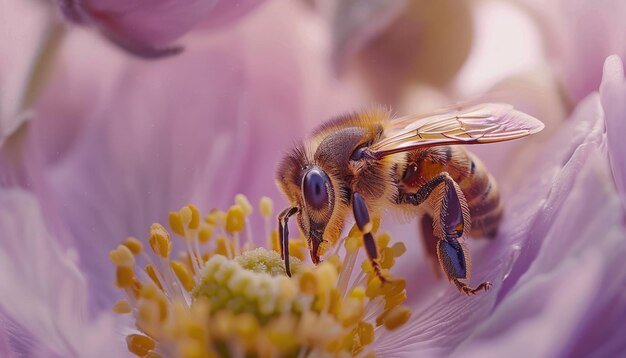
You might be wondering why this pollination process is so crucial. Simply put, many of the foods we eat and the lush landscapes we enjoy rely on bees to thrive. Without them, the food chain would be significantly disrupted, and many plants would struggle to survive. So, let’s dig deeper into the fascinating world of honey bees and their superhero-like role in pollination.
What is Pollination?
Pollination is the process where pollen from the male part of a flower (the anther) is transferred to the female part (the stigma). This process is essential for fertilization, which ultimately leads to the production of seeds and fruit. Think of pollen as a flower’s way of spreading its genes to the next generation, ensuring the survival of its species.
While many types of pollinators exist—like butterflies, bats, and wind—honey bees are some of the most efficient. They collect pollen on their bodies as they visit flowers searching for nectar. When they move to another flower, they unintentionally transfer pollen, allowing fertilization to occur. It’s like a flower’s version of a matchmaking service!
The Importance of Honey Bees
Honey bees are responsible for pollinating about one-third of the food we consume. This includes fruits, vegetables, and nuts—everything from juicy apples to crunchy almonds. Their role goes beyond just food, as they also help in the growth of plants that provide habitat and oxygen for other species.
Research shows that honey bees contribute to over $15 billion worth of crop production in the United States alone. Without them, many of these crops would produce far less fruit or fail entirely. The loss of honey bees would be like taking a crucial player out of a team; the whole system could collapse.
How Honey Bees Pollinate
Honey bees are social creatures that live in colonies, which can consist of thousands of individuals. Each bee has a specific role. For example, worker bees—who make up the majority of the colony—are primarily responsible for foraging for food. They visit flowers to collect nectar, which they turn into honey, and gather pollen to feed their young.
When a worker bee lands on a flower, it uses its legs and tongue to gather nectar and pollen. The bee’s body is covered in tiny hairs, allowing it to collect and hold onto pollen grains as it moves. After visiting multiple flowers, the bee transfers this pollen to the next blossoms it visits, unwittingly performing the vital act of pollination.
The Lifecycle of a Honey Bee
To understand how honey bees contribute to pollination, it’s helpful to know a bit about their lifecycle. A honey bee goes through several stages: egg, larva, pupa, and adult.
– Egg: A queen bee lays eggs in hexagonal wax cells.
– Larva: After a few days, the eggs hatch into larvae, which are fed by worker bees.
– Pupa: The mature larvae spin cocoons and enter the pupal stage, where they undergo transformation.
– Adult: After about three weeks, adult bees emerge, ready to contribute to their colony and, of course, pollination.
This process is not just about individual bees; it reflects the health of the entire hive. A thriving colony means more bees available to pollinate, leading to better food production and biodiversity.
Benefits of Pollination for Plants
Pollination brings several benefits to plants, creating a ripple effect in the ecosystem. When pollination occurs:
– Fertilization: Plants can produce seeds, leading to the next generation of plants.
– Fruit Production: Many fruits rely on pollination to develop, meaning more food for animals—and us!
– Genetic Diversity: Cross-pollination promotes genetic diversity, strengthening plant populations against diseases and environmental stress.
Plants that are pollinated by honey bees often exhibit better yield and quality. For farmers, healthy pollination can translate to better harvests, making honey bees invaluable to agriculture.
Challenges Facing Honey Bees
Sadly, honey bees are facing numerous challenges today that threaten their populations and, by extension, our ecosystems. Some major factors include:
– Pesticides: Certain chemicals used in farming can be toxic to bees, affecting their ability to forage and reproduce.
– Habitat Loss: Urbanization and agricultural expansion often lead to the loss of flowering plants, which provide food and nesting sites.
– Climate Change: Changes in temperature and weather patterns can disrupt the timing of flowering plants and bee activity, throwing off their synchrony.
These challenges paint a concerning picture for the future of honey bees and the critical role they play in our environment.
What Can We Do to Help?
As individuals, there are small actions we can take to support honey bee populations:
– Plant Bee-Friendly Flowers: Grow a variety of native plants that bloom at different times to provide consistent food sources.
– Avoid Pesticides: Opt for natural pest control methods and avoid harmful chemicals in your garden.
– Support Local Beekeepers: By purchasing local honey, you help sustain beekeepers who are dedicated to protecting these vital pollinators.
– Educate Others: Spread the word about the importance of honey bees and the challenges they face.
Every little bit counts! By making these changes, you can contribute to a healthier environment for honey bees and, ultimately, for ourselves.
Honey bees are more than just producers of honey; they are crucial players in our ecosystem’s health and food production. Their role in pollination directly affects the plants we rely on for nutrition and for the beauty of our natural spaces. As we face challenges that threaten their existence, it’s essential to recognize their importance and take action to protect them.
Let’s not forget the interconnectedness of life; when we nurture honey bees, we help sustain a healthy planet for ourselves and future generations. So, the next time you see a bee buzzing around, remember they’re not just after nectar; they’re playing a vital role in keeping our world alive and flourishing.
